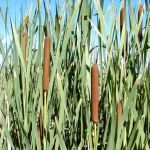| Common Name: |
Great Reedmace |
| Other Names: |
Cattail |
| Botanical Name: |
Typha latifolia |
| Genus: |
Typha |
| Family: |
Typhaceae |
| Native Location: |
Europe, Asia, N Africa, and North America |
| Cultivation: |
Wet soi or shallow water in sun or shade. Subject to statuatory control as a weed in parts of Australia. |
| Propagation: |
By seed sown in spring (species only); by division in spring. |
| Harvest: |
Pollen is gently shaken from flower spikes when blooming, and dreid for use in decoctions, pastes, powders, and suppositories. |
| Variations: |
Variegata
Haas white striped leaves.
Width: 0.9-1.2m (3-4ft). |
|
| Height: |
2.5m (8ft) |
| Width: |
Indefinite |
| Hardiness: |
Z2-9 |
| Parts Used: |
Pollen (pu huang) |
| Properties: |
A sweet, acrid herb that is diuretic, controls bleeding, improves the circulation, promotes healing, and stimulates the uterus. Dried pollen is anti-coagulant; roasted with charcoal, it becomes hemostatic. |
| Medicinal Uses: |
Internally for hemorrhage, painful menstruation, abnormal uterine bleeding postpartum pains, angina, and cancer of the lymphatic system. Externally for tapeworms, diarrhea, and injuries. May be combined with honey for abscesses and with powdered cuttlefish bone for bleeding injuries. |
| Culinary Uses: |
Unripe flower spikes can be cooked as a vegetable. Pollen may be used to enrich flour for baking. Young shoots and inner stems, known as "Cossack asparagus", are eaten raw or cooked. |
| Economic Uses: |
Pollen is highly flammable and was used in the manufacture of fireworks. |
| Bibliography: |
Encyclopedia of Herbs by Deni Brown Copyright © 1995, 2001 Dorling Kindersley Limited Pg 396 |
